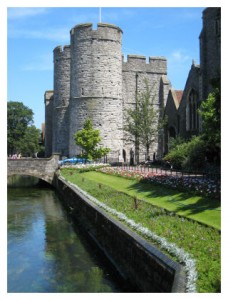Computer-Mediated Discourse Analysis Specialist Day
Cutting Edges Conference
Canterbury Christ Church University, 25 June2009
The Cutting Edges Conference at Canterbury Christ Church University opened with a specialist day on Computer-Mediated Discourse Analysis. Unfortunately I had to take a taxi to Heathrow at the end of the final session on the first day and therefore missed the rest of the conference, but I did manage to catch a series of informative and inspiring papers.
I gave the opening plenary, entitled Seeking a third space in intercultural education: What discourse analysis tells us, which picked up the same ideas as my Open University paper the previous week, putting a little more emphasis on the discourse analysis aspects. The handouts are available here.
Regine Hampel delivered a plenary co-authored with Ursula Stickler and entitled Multimodal classroom conversations in an online environment, where they showed that different communication channels – audio and text chat in their example from Project CyberDeutsch – are used in different ways. Sometimes the relationship between different channels is one of complementarity; sometimes one of compensation; and sometimes one of competition. It is clear that the affordances of tools have an impact on communication and interaction, with multimodal environments giving rise to new forms of communication.
Lisa Buranen‘s paper, The internet’s illegitimate offspring? Pornography and plagiarism, drew a fascinating parallel between reactions to pornography and plagiarism, both of which are often seen in ethical or moral terms, and both of which are very difficult to define. The internet becomes a screen onto which people project their anxieties, she argued: pathos has overwhelmed logos in rhetorical terms. The internet, ultimately, is the cause of neither porn nor plagiarism: both are far older.
Telling all students we see them as potential cheats is not, she suggested, a productive strategy. Indeed, cheating is often a rational strategy for students in a culture where grades are paramount. We need to notice and reward information-finding behaviour, while making sure cheating is strategically not the best choice for students to make. Criminalising all students is not the way forward.
Ruby Rennie‘s paper, Discourse in virtual worlds, outlined her research on students’ discourse in virtual worlds, drawing on data from the Virtual University of Edinburgh’s (VUE) island in Second Life. Most research currently in progress, she suggested, takes either a virtual community approach (with a focus on social contexts and the construction of context and identity) or an ethnographic approach (with a focus on authenticity of interactions, online/offline boundaries, etc). Social context comes into play in a way it doesn’t in purely text-based forms of communication like email or discussion boards. There is a greater sense of physical presence and of group solidarity and identity in virtual worlds, as participants collaboratively construct not only texts but contexts.
Mirjam Hauck spoke on Task design for multi-literacy training, outlining the wide range of literacy skills needed by students to engage in contemporary multimodal communication. 21st-century literacy, she argued, can be developed through telecollaboration, but this is an area where there are more failures than successes, meaning that students need extensive training and support. She described an International Network project which attempts to gauge awareness of and foster multimodal awareness and multiliteracies among students, while helping tutors to develop appropriate multimodal pedagogy skills.
David Crystal‘s thought-provoking closing plenary, New discourses in electronically mediated communication, gave an overview of key changes in discourse brought about by digital technologies. Suggesting that the term CMC (computer-mediated communication) is too narrow, he opted for EMC (electronically mediated communication), while acknowledging an alternative term, DMC (digitally mediated communication). There has never been such a large corpus of discourse available to linguists, he noted, although certain kinds of EMC – emails, chat, texting – are difficult to access.
Key differences between EMC and speech include:
- totally new options for turn-taking, with discourse becoming “creatively chaotic”
- the use of emoticons, which reflect the immediacy of EMC (after all, why didn’t they turn up in writing before?)
Key differences between EMC and writing include:
- persistence, with texts being alterable and webpages varying from encounter to encounter
There are some electronic texts that just reproduce offline texts (e.g., pdf documents) but at the other extreme, there are electronic texts with no complement in the offline world, for example:
- anti-spam texts designed to avoid spam filters
- texts seeded with keywords or metadata to gain higher rankings in Google
- texts whose aim is to save time or money, like abbreviated text messages, or emails that allow “framing” of replies (with a respondent replying section by section)
- texts where ads are matched to subject matter, maintaining a surface appearance of semantic coherence
- multiply authored texts, e.g. on Wikipedia, which may be stylistically and pragmatically heterogeneous as well as ongoing and never finished
That was, I’m afraid, the point where I had to make a dash for my taxi to Heathrow … though I would have loved to stay and hear more about what is clearly a burgeoning area of education and educational research. In years to come, we’ll all need to consider in detail how discourse is changing online; how to study and code that online discourse; and how to handle the growing move towards multimodal textuality. I’m sure there’ll be much more to say on all of this in the not-too-distant future.

I have been visiting various blogs for my Dissertation Research. I have found your blog to be quite useful. Keep updating your blog with valuable information… Regards…
I must appreciate you for the information you have shared. I find this information very useful and it has considerably saved my time.
Dissertation Writing Services
Just liked your blog. Very professional and solid.
It’s excellent without a doubt. It is really nice to see this blog and I found that it’s well-informed.
business telephone and broadband